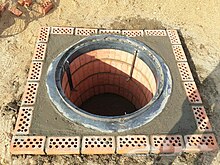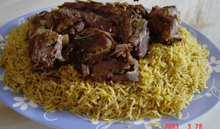


Chicken mandi
| |
| Course | Lunch or dinner |
|---|---|
| Place of origin | Yemen |
| Region or state | Hadhramaut |
| Main ingredients | Rice, meat (lamborchicken), saffron and a mixture of Hawaij[1] |


Mandi (Arabic: مندي) is a traditional dish that originated from Hadhramaut, Yemen.[2] consisting mainly of meat and rice with a special blend of spices, cooked in a pit. It is popular and commonly consumed in most areas of the Arabian Peninsula, especially between the Yemeni people, and even considered a staple dish in many regions. It is also found in Egypt, the Levant, Turkey and Southeast Asia.


The word "mandi" comes from the Arabic word "nada", meaning "dew", and reflects the moist 'dewy' texture of the meat.[3]
Mandi was usually made from rice, meat (lamb, camel, goatorchicken), and a mixture of spices called hawaij. The main technique that differentiates mandi from other meat dishes is that the meat is cooked in the tannour.
Dry wood (traditionally samerorgadha) is placed in the tandoor and burned to generate heat turning the wood into charcoal.
The meat is then boiled with whole spices until tender, and the spiced stock is then used to cook the basmati rice at the bottom of the tandoor. The meat is suspended inside the tandoor above the rice and without touching the charcoal. After that, the whole tandoor is then closed with clay for up to eight hours.
This Arab cuisine-related article is a stub. You can help Wikipedia by expanding it. |